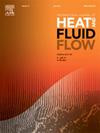热水淋浴灭菌过程中输液袋的传热和动态变形:一个数值高效的两步CFD多相模型
IF 2.6
3区 工程技术
Q2 ENGINEERING, MECHANICAL
International Journal of Heat and Fluid Flow
Pub Date : 2025-04-25
DOI:10.1016/j.ijheatfluidflow.2025.109850
引用次数: 0
摘要
在液体药品生产过程中,热水淋浴灭菌对确保患者安全至关重要。当在较低温度水平下进行时,该过程也可应用于食品的热加工。通过水淋浴对药品或食品进行高能耗加热和冷却,缺乏数值上有效的多相模型进行优化。本研究引入了一种数值上便宜的两步模拟模型。在第一步中,分析了多相流和产品的传热,并计算了局部时间平均的表面传热系数。然后在第二步中使用该系数作为对流边界条件,该条件仅模拟产品的内部流动。500ml聚丙烯输液袋作为试验品。该模型考虑了水膜的影响、袋壁的动态变形、袋与下孔板之间的传导以及可能的冷凝。在实验室规模的测试台上,通过产品温度、定性流态分析和膜厚测量验证了数值模型。模拟产物温度与实验产物温度的误差大都在±1.0 K以内。最慢的加热区和最慢的冷却区分别位于袋子高度的15%和85%。在袋子加热过程中,袋底和孔板的传热对总传热有显著影响。该模型的高数值效率使实际应用和升级,为输液袋中的传热机制提供有价值的见解。本文章由计算机程序翻译,如有差异,请以英文原文为准。
Heat transfer and dynamic deformation in infusion bags during hot water shower sterilization: A numerically efficient two-step CFD multiphase model
Hot water shower sterilization is crucial for ensuring patient safety during the manufacturing of liquid pharmaceutical products. This process, when performed at lower temperature levels, can also be applied to the thermal processing of foods. The energy-intensive heating and cooling of pharmaceutical or food products by water showering lack numerically efficient multiphase models for optimization. This study introduces a numerically inexpensive two-step simulation model. In the first step, the multiphase flow and heat transfer to the product are analyzed, and a local, time-averaged surface heat transfer coefficient is calculated. This coefficient is then used as a convective boundary condition in the second step, which simulates only the internal flow of the product. A 500 ml polypropylene infusion bag was used as a test product. The model considers the influence of the water film, dynamic deformation of the bag wall, conduction between the bag and the underlying hole plate, and possible condensation. The numerical model was validated with product temperature, qualitative flow regime analysis, and film thickness measurements on a lab-scale test bench. The error between the simulated and experimental product temperature was mostly within 1.0 K. The critical slowest heating and cooling zones inside the bag were found to be at 15 % and 85 % of the bag height, respectively. Heat transfer from the bag underside and the hole plate significantly influenced the total heat transfer during the heating of the bag. The model’s high numerical efficiency enables practical application and upscaling, offering valuable insights into heat transfer mechanisms in infusion bags.
求助全文
通过发布文献求助,成功后即可免费获取论文全文。
去求助
来源期刊

International Journal of Heat and Fluid Flow
工程技术-工程:机械
CiteScore
5.00
自引率
7.70%
发文量
131
审稿时长
33 days
期刊介绍:
The International Journal of Heat and Fluid Flow welcomes high-quality original contributions on experimental, computational, and physical aspects of convective heat transfer and fluid dynamics relevant to engineering or the environment, including multiphase and microscale flows.
Papers reporting the application of these disciplines to design and development, with emphasis on new technological fields, are also welcomed. Some of these new fields include microscale electronic and mechanical systems; medical and biological systems; and thermal and flow control in both the internal and external environment.
 求助内容:
求助内容: 应助结果提醒方式:
应助结果提醒方式:


